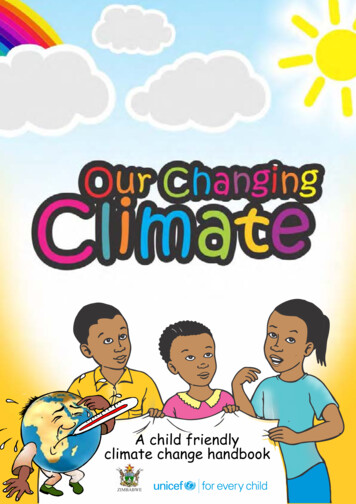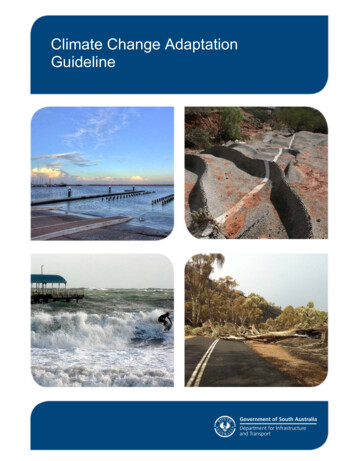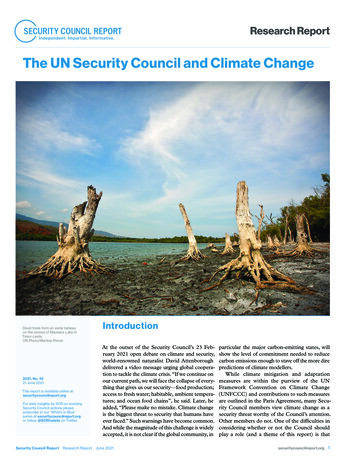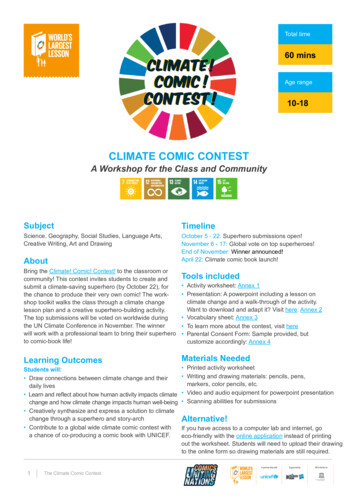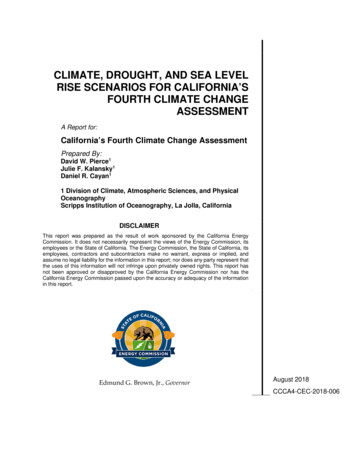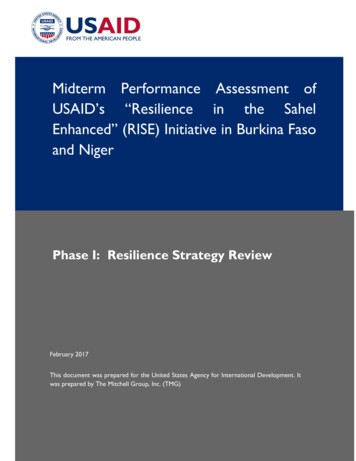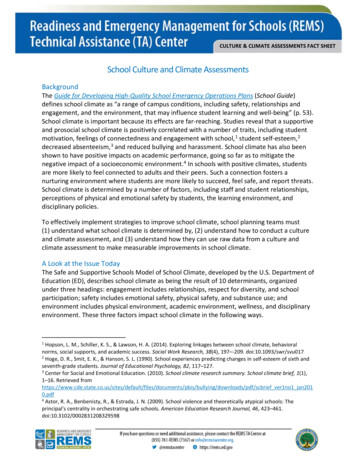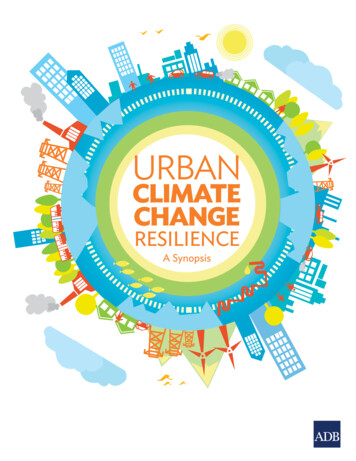
Transcription
URBANCLIMATECHANGERESILIENCEA Synopsis
2014 Asian Development BankAll rights reserved. Published in 2014.Printed in the Philippines.Publication Stock No. ARM146551The views expressed in this publication are those of the authors and do not necessarily reflect the views andpolicies of the Asian Development Bank (ADB) or its Board of Governors or the governments they represent.Note:In this publication, “ ” refers to US dollars.6 ADB Avenue, Mandaluyong City1550 Metro Manila, PhilippinesTel 63 2 632 4444Fax 63 2 636 2444www.adb.orgFor orders, please contact:Public Information CenterFax 63 2 636 2584adbpub@adb.orgPrinted on recycled paper
Contents1Introduction42Core Principles and Qualities63Planning for Resilience94Knowledge145Investments and Projects176Further Reading26
1. IntroductionCities across the globe, particularly those with urban poorcommunities, face long-term challenges in ensuring the wellbeing of their inhabitants. These challenges are partly a resultof direct and indirect impacts of climate change, and are oftencompounded by preexisting vulnerability. Urban resilience isthe capacity of cities to function, so that the people living andworking in cities—particularly the poor and vulnerable—surviveand thrive no matter what stresses or shocks they encounter.Urban Climate Change ResilienceThe concept of resilience has been useful in addressing climaterisk and unexpected events, and in enhancing efforts to surviveand thrive in the context of climate change.1Urban climate change resilience (UCCR) embraces climatechange adaptation, mitigation actions, and disaster riskreduction while recognizing the complexity of rapidly growingurban areas and the uncertainty associated with climatechange. This approach places greater emphasis on consideringcities as dynamic systems capable of evolving and adapting tosurvive and even thrive in the face of volatile shocks or stresses.Urban resilience to climate change describes a city that isresilient on three levels:y the systems of the city survives shocks and stresses;y the people and organizations are able to accommodate thesestresses into their day-to-day decisions; andy that the city’s institutional structures continue to support thecapacity of people and organizations to fulfil their aims.Maintaining essential urban functionsActions to build resilience should respond to threekey questions:1. How does the city work (the urban systems)?2. What are the direct and indirect impacts of climatechange (climate change)?3. Who is least able to respond to shocks and stresses(vulnerable groups)?Figure 1 highlights that the action focusing on disaster riskreduction and/or urban poverty reduction is necessarybut insufficient to maintain urban functions in the face ofdirect and indirect climate change impacts.11 How does thecity work?UrbanpovertyreductionURBANSYSTEMSUrbanclimate riskmanagement2 Who is least ableto respond to shocksand stresses?3 What are the directThere is no single action that will make a city resilient to climatechange. Resilience is instead achieved through a number ofactions, building upon each other over time. These actionswould be enhanced and progressed as peoples and institutionslearn from past experiences and apply it to future decisions.VULNERABLEEGROUPS3and indirect impactsof climate change?CLIMATECHANGEDisasterriskreduction2Direct impactIndirect impactFigure 1: Conceptualizing Urban Resilienceto Climate ChangeSource: Da Silva, et al. 2012.1Asian Cities Climate Change Resilience Network. 2013. ACCCRN City Projects.
Introduction 5As detailed in Section 2 (page 3) of this Synopsis, buildingUCCR is founded on the following principles and qualities thatmust be integrated into any effort to advance action:y Principles: combining hard and soft measures, engaging diverseperspectives through multistakeholder processes, engagingdifferent geographic and governance scales, addressingtoday’s problems while embedding a long-term vision, tappinginto local expertise, building leadership and local action, andfocusing on vulnerable communitiesy Qualities: reflective, robust, redundant, flexible, resourceful,inclusive, and integratedWhy second-tier cities?Residents of second-tier cities have very different levels ofaccess to services. This differentiation is a product of rapidincrease in urban population and demand for services, a lack offunding, inadequate planning, and preexisting patterns of socialmarginalization.2 Large sections of the urban population lackeconomic power and political voice, and an increasing numberof people are living in slums.At the same time, these cities will still be making significantdecisions on planning, land-use, and major investment projects.It is during these decisions that the interactions betweenclimate change and urban development can be effectivelyaddressed. This type of decision making will assist in managingthe challenges of current development whilst also consideringthe future scenarios of climate change.Who (and what) is most at risk?Urban areas that are most susceptible to external shocksand stresses (including climate change) are those that havefragile systems as well as large populations of the socially oreconomically marginalized. These impacts are most felt byvulnerable people as a result of their high exposure to hazards,or a lower ability to adapt and respond (due to physicallimitations or financial capacity).The direct impacts of climate change are twofold: shocks andsudden impacts such as storms, typhoons, and heat waves; andstressors or impacts that build gradually over time such as sealevel rise, average temperature increase, and long-term changesin rainfall patterns. Between 2000 and 2012, the damage fromnatural disasters was 1.7 trillion globally.2Purpose of this SynopsisWhat is it for? To provide a concise introduction to urbanclimate change resilience, including the core conceptsand principles, relevant processes, experiences fromimplementation, and outcomes sought from a UCCRbased approach.Who is it for? For ADB project officers, consultants, andpartners who are interested in UCCR. It explains howUCCR is understood in the context of Urban ClimateChange Resilience Trust Fund, managed by ADB.Why is it necessary? To communicate the principles,processes, and practices associated with UCCR in asuccinct and accessible way. UCCR is a relatively newapproach to addressing the uncertainty that climatechange and rapid urbanization bring to cities.DefinitionsClimate Change Mitigation: actions to reduce emission ofgreenhouse gasses. Intergovernmental Panel on ClimateChange (IPCC)Climate Change Adaptation: adjustment in natural orhuman systems in response to actual or expected climaticstimuli or their effects, which moderates harm or exploitsbeneficial opportunities. (IPCC)Urban Climate Change Resilience: capacity of cities tofunction, so that the people living and working in cities—particularly the poor and vulnerable—survive and thrive inthe face of shocks and stresses related to climate change.Indirect impacts on urban areas resulting from these shocksand stresses include: severe flooding (stopping port or trainoperations, thus affecting travel to work and preventing goodsto reach market); blackouts (as energy generation is affectedby storms); increased risk of water- or vector-borne diseases(due to rainfall and changes in temperature ); and heat stress(exacerbated by temperature increase). An increase in diseaseincidence and heat stress can put pressure on the health systemand infrastructure during climatic events.A. Brown, A. Dayal, and C. Rumbaitis Del Rio. 2012. From practice to theory: emerging lessons from Asia for building urban climate change resilience. Environmentand Urbanization.
2. Core Principles and QualitiesUrban climate change resilience can be found in cities that haveavoided system-wide collapse to those that have transformedhow they function in the face of disruption. Achieving resilientoutcomes demands that a series of core principles areintegrated into any effort to advance action, i.e., a process that isiterative, inclusive, and integrated. There are some generalizablequalities observable in resilient cities relating to the systemsand the capacities of stakeholders—from different parts of citygovernment to the business sector and civil society—who canshape those systems to create climate change resilience.Guiding Principles of Urban ResilienceCombining hard and soft measures. Capacities, networks, andbehavior (of individuals, communities, and institutions) are ascritical as physical systems during disruption. Soft measuresinclude new regulations, technology and information systems,and social networks.Engaging diverse perspectives through multistakeholderprocesses. Given a city’s varied socio-economic groupsand economic interests, engaging across different sectors(government, business, civil society, and academia) anddifferent departments within city government can result to themost transformative changes.Enlist different geographic and governance scales: Beyond cityboundaries. Considering the interconnectedness of marketsand economies, it is important to understand how systems(economic, physical, ecological, political mechanisms) withinand beyond the city affect how it functions. There is also aneed to understand how to best enlist stakeholders at differentscales.Addressing today’s problems while embedding a long-termvision: The future is now. The city’s decision makers oftenfind it difficult to look beyond current challenges, particularlywhen change is unpredictable. Planning processes should beginby addressing the current needs (e.g., water supply or urbandrainage). Building on existing issues and analyzing how climatechange might change or increase existing hazard risk is one wayto bring future scenarios into current decision making.CASE STUDYDavao City, PhilippinesIn 2013, UN-Habitat and World Food Programme usedmultistakeholder and multisector processes to engage DavaoCity in a 7-month program to deepen understanding of spatialand sectoral vulnerability to climate change. This program ledto the identification of preliminary resilience building optionswhich were prioritized through a city-wide consultation.Engage the cityƷɆ .%! *#Ɇ "Ɇ( (Ɇ %!"Ɇ 4! 10%2!Ɲ ! !./ƷɆ .) 0% *Ɇ "Ɇ ! *% (Ɇ .'%*#Ɇ . 1,/ɆƠ /ơƷɆ %#*%*#Ɇ "Ɇ !) . * 1)Ɇ "Ɇ #.!!)!*0ɆƠ ơ * 1 0Ɇ0 !Ɇ 1(*!. %(%05Ɇ * Ɇ ,0 0% *Ɇ //!//)!*0ƷɆ (%) 0!Ɇ *#!Ɇ .%!*0 0% *ɆƠ (1/0!.Ɇ .'/ ,ơƷɆ 4, /1.!Ɇ * (5/%/ƷɆ !*/%0%2%05Ɇ * (5/%/ƷɆ ,0%2!Ɇ , %05Ɇ * (5/%/ƷɆ %*#Ɇ * Ɇ)!*0 .%*#Ɇ/!//% */ %05Ɇ * Ɇ ))1*%05Ɇ2 (% 0% *Ɇ * Ɇ( (Ɇ ,0 0% *Ɇ,( **%*#ƷɆ ))1*%05Ɇ" 1/Ɇ#. 1,Ɇ %/ 1//% */ƷɆ %05Ɇ */1(0 0% *ɆɆ Ơ !/1(0/Ɇ "Ɇ0 !Ɇ Ɇ * Ɇ 0/, 0Ɇ //!//)!*0/ơƷɆ .)1( 0% *Ɇ "Ɇ (%)0!Ɇ *#!Ɇ 0% *Ɇ ( *Figure 2.1: Vulnerability Assessment Process for Davao CitySource: UN Habitat.
Core Principles and Qualities 7UCCR: an integrated approach to climateproofing projects“Climate proofing” efforts on individual projectssometimes aim to make single piece of infrastructuremore durable in the face of changing climate risk. Whenconsidered at the city scale, a collection of single actionshas the potential to either improve or erode the resilienceof the city by affecting the flexibility of urban systems tohandle surprise and multiple interacting impacts.In Quy Nhon, Viet Nam, roads and houses were raisedabove the potential water level in response to increasingseasonal flooding. While each piece of infrastructureendured higher water levels better, the system as a wholesuffered—higher roads blocked natural drainage channelsduring a 2009 storm, causing flooding in new areas andmore intensively in areas that had learned to manageseasonal ibleIntegratedResourcefulFigure 2.2: Resilience qualitiesSource: Arup. 2014.Tapping into local expertise. Engaging local technical experts(e.g., researchers and academics) enables dialogues to be heldon a sustained basis. For example, external experts may bepaired with local technical institutions to bridge the qualityengagement trade off and build long-term adaptive planningcapacity.Reflective. People and institutions systematically learnfrom experience, with an adaptive planning mindset thataccepts unpredictable outcomes. They have mechanisms tocontinuously modify standards based on emerging evidence,rather than seeking permanent solutions based on anassessment of today’s shocks and stresses.Building leadership and local action. Efforts to build resilienceare most likely to be accelerated and sustained through strongleadership, driving commitment, and accountability with activecommunity engagement to build awareness.Robust. Robust city systems are designed and managed towithstand the impacts of extreme conditions and to avoid acatastrophic collapse of the city from the failure of a single element.A robust system anticipates system failures and makes provisions tomaximize predictability and safety.Focusing on vulnerable communities: Whose resilience? Thelitmus test for a meaningful urban resilience approach is itsrelevance to the interests of poor or vulnerable households. Whileresilience measures must be provided at multiple levels, it isimportant to constantly ask ‘resilience for whom?’ to establish theirpractical value and to ensure that equity concerns are kept at theheart of the agenda.Redundant. Redundancy is to deliberately plan capacity toaccommodate for increasing demand or extreme pressures– if one component of the system fails, other pathways orsubstitutable components can meet essential functional needs.One example is having multiple pathways to access water, suchas city supply, water tankers, wells and tanks etc. Overrelianceon a system ‘fail-safe’ can expose an underlying lack ofresilience.Resilience qualitiesResilient cities demonstrate observable qualities through theirstakeholders and urban systems. These qualities are describedbelow and in Figure 2.2, and illustrated in practice in Section 4.434Flexible. Flexibility is a city with systems that can change, evolveand adopt alternative strategies (in either the short or longerterm) in response to changing conditions. These systems tendto favor the decentralization of conventional infrastructureA. Brown and S. Kernaghan. 2011. Beyond Climate-Proofing: Taking an Integrated Approach to Building Climate Resilience in Asian Cities. UGEC Viewpoints, No. 6.Arup. 2014. City Resilience Framework. The Rockefeller Foundation.
8 Urban Climate Change Resilience: A Synopsiswith new technologies. For example, super storm Sandy in NewYork has brought into focus the value of decentralized energysystems in urban centers.Resourceful. People and institutions should invest in capacity toanticipate future urban conditions, set priorities, and mobilizeand coordinate the resources (human, financial, and physical).Resourcefulness prepares a city to respond quickly to extremeevents, modifying organizations or procedures as needed.Inclusive. An inclusive approach is one that includes theconsultation and engagement of communities, particularlythose who are vulnerable. A city cannot build resilience inisolation of others. Resilience needs collective ownership andjoint vision from various groups within the city.Integrated. City systems, decision making, and investmentsshould be mutually supportive of a common outcome. Resilientsystem integration has evidence of systems that exist acrossdifferent scales of operation. Integration requires ongoingfeedback system for collection of information and response.KEY QUESTIONSƷɆ !/%(%!* !Ɇ" .Ɇ3 )ƊɆƷɆ 3Ɇ *Ɇ0 !Ɇ#1% %*#Ɇ,.%* %,(!/Ɇ/1,, .0Ɇ.!/%(%!* !Ɇ,( **%*#Ɇ * Ɇ,. &! 0Ɇ !/%#*Ɇ3 % Ɇ0 .#!0Ɇ1. *Ɇ, .ƊƷɆ Ɇ*!3Ɇ,. &! 0/Ɇ !) */0. 0!Ɇ Ɇ. *#!Ɇ "Ɇ.!/%(%!* !Ɇ-1 (%0%!/ɆƠ.! ! 0%2!ƂɆ. 1/0ƂɆ.! 1* *0ƂɆ !4% (!ƂɆ.!/ 1. !"1(ƂɆ%* (1/%2!ƂɆ* Ɇ%*0!#. 0! ơƊƷɆ .!Ɇ0 !/!Ɇ-1 (%0%!/Ɇ "Ɇ.!/%(%!* !Ɇ*!! ! Ɇ%*Ɇ0 !Ɇ/5/0!)/Ɇ0 0Ɇ/1,, .0Ɇ0 !Ɇ"1* 0% *%*#Ɇ "Ɇ0 !Ɇ %05Ɗ
3. Planning for ResilienceAction to build UCCR should be informed by an iterative,inclusive, and integrated planning process which respondsto three interlocking frameworks of analysis:y Urban Analysis, particularly understanding how the city works andexamining its current status and future trends (such as population growthand economic development);y Climate Change Risk Analysis, particularly projections of direct andindirect climate impacts; andy Vulnerability Analysis, particularly of the urban population that faces highexposure risk to climate change impacts and has limited coping capacitywith which to weather these impacts.The process of bringing these elements together inidentifying actions to build urban climate change resilience isknown as climate change resilience planning, and is outlinedin more detail in this section.Engagement with multiple stakeholders needs to be morethan a once-off activity. Engagement that uses an adaptivecycle of action and reflection progressively builds capacity andunderstanding over time. This iterative process can increase thecapacity of decision makers (business, community, household,or government) to incorporate new information and uncertainty(related to climate, urban growth, and vulnerability) into futureplans and actions.Multistakeholder, multisector engagement. Governmentsoften work in silos, carrying out limited stakeholder engagement(with local and national government authorities, communityrepresentatives, business leaders, financing partners, and Time* Time*redo flectcum anen dtResilience planning builds on iterative, inclusive, and integratedprocesses to reduce the uncertainty and complexity of rapidurban growth and climate change (as described below and inFigure 3.1). Time*redo flectcum anen dtResilience planning is the process of bringing togethertechnical, scientific, and local knowledge into city decisionmaking processes. It does not refer specifically to spatial orinfrastructure planning, which are likely to be action areasidentified in the planning process.Knowledge and undestandingIterative, Inclusive, and IntegratedTime* Actions examples:- Scenario planning with community- Vulnerability assessment- Climate risk analysisFigure 3.1: An iterative, inclusive, and integratedplanning processesSource: ISET. 2013.
10 Urban Climate Change Resilience: A Synopsisacademics) on urban challenges and potential solutions.Bringing together a wide range of stakeholders to discussscientific information (climate change projections), governance,or technical studies provides an opportunity for findings tobe verified from multiple perspectives. Implications of andresponses to these issues can then be discussed.Visioning and scenario planning. Scenario development can bea powerful tool for planning for urban and climatic uncertainty. Itis designed to stretch their thinking about emerging changes andthe opportunities and threats that the future holds.Scenario planning can be used to focus on the impacts ofclimate change on urban growth trajectories, or to understandhow climate change might affect specific sectors due toinsufficient water supply coverage, recurrent flooding, orextreme average temperature.Plan and prioritize actions. Resilience planning involves thedevelopment of a strategy that documents the cumulativeunderstanding of current and future vulnerability, and identifiesstrategies and actions to build resilience over time. Prioritizingactions enables cities to identify what can be done now, and toidentify which actions can reduce the existing city resilience deficit.CASE STUDY 1. 0ƂɆ * %In response to 2006 flooding, and as part of a climateresilience planning process, city stakeholders inSurat developed a City Resilience Strategy in 2010.Surat undertook a systems analysis to gain a deeperunderstanding of gaps or deficits in the infrastructure,institutions, and knowledge sharing processes in the city,and whether they were enabling or preventing resilience.Through this process, an end-to-end early warning systemwas conceived which looked beyond administrativeboundaries and engaged with multiple levels of government.The core infrastructure, dams and SMS based warningwere already in place, leaving Surat to focus on improvingaccess to knowledge, and building the capacity of existinginstitutions. For instance, the project improved the qualityof data through comprehensive hydrological catchmentmodeling, and how that information was shared betweendecision makers, interpreted, and made accessible tovulnerable people.6EcosystemsFailures in networked infrastructure, such as the Surat Plaguein 1994 which resulted in 52 deaths, have revealed howcomplex and interdependent the systems of a city are. Theseevents show how delicate essential infrastructure may be andhighlights the importance of regular repair and maintenance toensure that these services can respond to shocks and stresses.5Spatial analysis is often used to assess the direct impacts of climateon an urban population and sectors. However conventional spatialanalysis neglects to consider the reliance of communities in onelocation with infrastructure (energy, water, transport) locatedelsewhere. Saline intrusion into a city’s water supply has wideimpacts on communities across a city, despite that water supplypotentially being located far from the consumers. Recognising theseindirect impacts through a systems based approach can thereforeimprove spatial analysis in the context of climate change.InfrastructureSystems thinking provides a platform for a more holisticapproach in which urban areas are considered as complex‘living’ systems undergoing numerous dynamic exchanges atany given time.UrbandrainagesystemCity floodprotectionmeasuresReservoirInstitutionsUrban Systems DisasterEarlyWarningSystemKnowledgeCLIMATE AND cypreparednessplansWellbeingFLOOD SAFETY AND SECURITYIntervention pointsFigure 3.2: Urban Systems Analysis ofSurat Flood ManagementSource: Da Silva, et al. 2012.56G. Bhat, U. Raghupathi, and U. Rajasekar. 2013. Urbanisation – Poverty – Climate Change: A Synthesis Report. India. Volume I and II.J. da Silva, S. Kernaghan, and A. Luque. 2012. A systems approach to meeting the challenges of urban climate change, International Journal of Urban SustainableDevelopment. pp.1-21.
Planning for Resilience 11An urban center’s resilience to climate change is influencedby its resilience to the stresses and shocks in the past. Thefirst aspect of any urban analysis is an assessment of itsresilience to those familiar shocks and stresses that climatechange is likely to exacerbate. For instance, as part of itsclimate resilience planning process, Indore, India focusedinitial studies on understanding vulnerability to climate changein the priority issue areas of urban health and environment,transport, water security, and energy security. The city thenused multistakeholder processes to identify and highlight crosssectoral linkages and capture the systemic interdependenciesthat needed action.The impacts of climate change on cities cannot always be managedby the municipality alone. Cities have to look for external assistanceto reduce risk. In Surat, India, the flood management system (UkaiDam) is outside the municipal boundary and controlled by theGujarat State Irrigation Department. This means that the city isunable to influence when and how much water is released, or tohave sufficient time and information to prepare themselves forresulting floods.Climate Risk AnalysisClimate risk analysis begins with an assessment of likelihood ofhazards due to potential changes in the climate (i.e. changes totemperature, rainfall, or the frequency of storms). Climate changeis impacting the type, frequency and extent of hazards that arefaced by cities, making future climate risks even more uncertain.CASE STUDY !) . *#ƂɆ * *!/%Semarang, Indonesia is facing another significant urbanclimate change resilience challenge as it is forced toextract groundwater to meet its residents’ basic needs.In 2010, Semarang developed a City Resilience Strategy8in response to the need to adapt to climate change. Aspart of this strategy, the city analyzed its vulnerabilities toclimate changes with regard to temperature, rainfall, andwind speeds.Coupled with an understanding of the city’s populationand practices, the analysis identified some vulnerabilities,such as:y Land subsidence as a side effect of groundwaterextraction, which is taking place at a rate of up to 10 cma year according to some estimates. This environmentalproblem has increased the city’s vulnerability to flooding.y Sea level rise of 21 cm by 2050 as a result of climatechange, which compounds the predicted subsidence.This will impact coastal infrastructure, making the portand train station particularly vulnerable.The indirect effects of coastal flooding includeinterruption of travel to work, shortages of goods, andfailure of goods to reach market (see image below).Uncertainty in climate information will make it increasingly difficultto support design specifications for infrastructure includingdams, dikes, and flood control channels. This uncertainty requiresplanners and engineers to find alternative design approaches thatare less dependent on climate specifics (i.e., focusing on systemrather than infrastructure resilience).7Engaging city stakeholders in the development of climate riskassessments can build confidence in the findings and createunderstanding of climate change projections. Benefits of thisapproach include:y City-level verification that inputs (data) being used arerepresentative and reliable, and that outputs (future hazardprofiles) are realistic based on local knowledge and experience.y Making documentation accessible to a “nontechnical audience”can improve understanding of the process and create theopportunity for further discussion of findings and implications.78ISET. 2013. Climate Resilience Framework: Training Materials. ISET International.Da Silva, et al. 2012.Tidal flooding impacting travel and ability to work inSemarang, Indonesia.Source: Arup.
12 Urban Climate Change Resilience: A SynopsisCASE STUDY 1(*!. %(%05Ɇ //!//)!*0/Ɇ%*Ɇ 1. 0ƂɆ * %The city of Surat, India used a geographicinformation system (GIS)-based vulnerabilityassessment focusing on spatial and socioeconomic vulnerability. Climate changescenarios for Surat indicate an increase inrainfall, with monsoons dominated by heavyspells of rain interspersed with longer dry spells.The key findings of the vulnerability assessmentwere:y One third of households have poor incomestability, indicating high sensitivity to changesin the economy and to disasters and externalshocks.y 71,000 households are prone to tidal flood risks(12% of households).y 450,000 households are at risk of suddenwater release from Ukai dam (74% ofhouseholds).Figure 3.3: Surat, Capacity and Vulnerability IndexSource: TARU.Lessons from integrating climate risk projections into resilienceplanning include:9y Timescales need to be relevant to policy and planningprocessesy Trends from global circulation models can provide enoughinformation to begin to act.y Cities often have no capacity to integrate models on their ownand need external support.y Hazard projection should not be combined, as each hazardneeds to be considered separately.y Climate modeling exercises should be accompanied by impactassessments on urban sectors, rather than just using spatialassessment of hazard impacts.Analyzing VulnerabilityClimate vulnerability is the degree to which someone orsomething can be affected by climate-related hazards (e.g.,short-term hazards such as storms to long-term changessuch as sea level rise). This term includes both people and thecontext in which they live.910Vulnerability analyses identify the current location anddynamics of vulnerable urban population, as well as thevulnerabilities across different sectors and urban systems.10By conducting vulnerability assessments, the cities gain:y an understanding of who and what are the vulnerable groups,areas, sectors, and urban systems;y protection from the range of factors that make them vulnerable,including direct factors (such as exposure to hazards) andindirect factors (such as access to energy, food, and watersystems); andy a knowledge of existing capacities to adapt.Vulnerable communities are particularly limited by the ability tomanage or adapt to climate impacts. This may be due to a rangeof issues such as having low education or health care, insufficientaccess to basic infrastructure (potable water, sanitation,drainage) or financial capacity constraints (unemployment,poverty or extensive debt).Nonresponsive political systems and bureaucratic structuresmean that communities may have a limited voice or powerto create change, and that they may lack safety nets (e.g.,D. Sharma, and R. Singh. 2013. Urban Climate Resilience: A review of the methodologies adopted under the ACCCRN initiative in Indian cities. ACCCRN Working PaperSeries 5. The Rockefeller Foundation.ISET. 2013.
Planning for Resilience 13insurance and savings) and information, which in turn limitstheir ability to adopt alternative strategies.For instance, fishermen are a particularly vulnerable group.11Households dependent on fishing tend to be among thepoorest and to live in weakly constructed houses, which arehighly prone to typhoons. This vulnerability will be exacerbatedover time as typhoons are expected to increase in intensityand frequency.Vulnerability assessments undertaken as part of the Asian CitiesClimate Change Resilience Network (ACCCRN) program placedgreater emphasis on understanding the current vulnerabilities andhow they might be exacerbated by climate change, in additionto projecting how ongoing climate change and climate variabilitymight create new vulnerabilities. This assessment helps to anchoran understanding of climate change in today’s context, rather thanin a future timefram
change (climate change)? 3. Who is least able to respond to shocks and stresses (vulnerable groups)? Figure 1 highlights that the action focusing on disaster risk reduction and/or urban poverty reduction is necessary but insuffi cient to maintain urban functions in the face of dir

